Table of Contents
The general method of assaying copper values is by what is termed the “wet” process, that is volumetric determination by titrating with standard solution of potassium cyanide. This method is very accurate when carefully done, but care must be taken to keep the standard solution at a given strength.
Preparation of Sample
The original sample of ore must be thoroughly mixed, quartered and pulped as described in Chapter I for gold and silver assay, except that pulp for solution or “wet” assays should be more finely pulverized than samples prepared for fire assay. Pulps for this operation should pass a sieve of 100 mesh.
Usual Assay Charge
Carefully weigh 0.5 gram (in case the ore be rich in copper), and place in a 250 c.c. beaker (Fig. 49).
Method of Treatment
Add 1 fiuidounce of mixed nitric and hydrochloric acid, having 2 parts nitric and 1 part hydrochloric.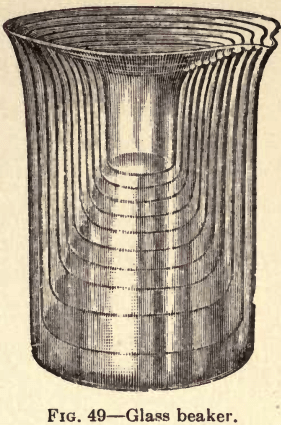 Place the beaker on the sand bath (Fig. 50), and apply gentle heat. As the acid evaporates from the beaker, maintain the original volume by the addition of water from time to time, using the wash bottle (Fig. 51) during the operation, and continue until the fumes cease. Before removing the beaker from the sand bath add drop by drop a very few drops of chemically pure sulphuric acid. This drives off any remaining nitrous oxide (red fumes) and helps to clean the solution.
Place the beaker on the sand bath (Fig. 50), and apply gentle heat. As the acid evaporates from the beaker, maintain the original volume by the addition of water from time to time, using the wash bottle (Fig. 51) during the operation, and continue until the fumes cease. Before removing the beaker from the sand bath add drop by drop a very few drops of chemically pure sulphuric acid. This drives off any remaining nitrous oxide (red fumes) and helps to clean the solution.
Agitate the solution from time to time by stirring with a glass rod. The copper contained in the sample will now be in 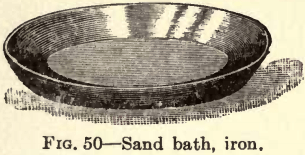 solution, and the silica or insoluble matter will look clear and white. This digestion will ordinarily take from ten to fifteen minutes. When the silica or gangue matter shows clear and white, bring up the volume in the beaker to about four ounces by adding warm water. Empty the contents of the beaker upon a small filter paper about seven inches in diameter previously folded and placed in a glass funnel (Fig. 52).
solution, and the silica or insoluble matter will look clear and white. This digestion will ordinarily take from ten to fifteen minutes. When the silica or gangue matter shows clear and white, bring up the volume in the beaker to about four ounces by adding warm water. Empty the contents of the beaker upon a small filter paper about seven inches in diameter previously folded and placed in a glass funnel (Fig. 52).
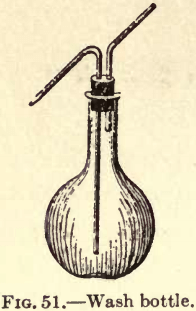 Rinse out the beaker with hot water, pouring it through the filter. Then carefully wash filter and gangue matter with hot water, using the wash bottle. This is to make sure that all copper solution may be washed out of the gangue and out of the filter paper into the receiving beaker beneath the funnel.
Rinse out the beaker with hot water, pouring it through the filter. Then carefully wash filter and gangue matter with hot water, using the wash bottle. This is to make sure that all copper solution may be washed out of the gangue and out of the filter paper into the receiving beaker beneath the funnel.
Add to the filtrate some stronger ammonia water until the filtrate becomes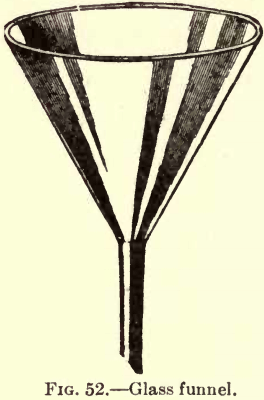 strongly alkaline, which will be shown by a deep blue color. Place filter containing the now alkaline filtrate on the sand bath, and bring it slowly to the boiling point. This operation precipitates all iron and alumina out of the solution. Prepare clean filter paper in the funnel and filter out precipitated iron and alumina. Wash the filter thoroughly with hot water as before so as to remove all traces of copper from the precipitate on the filter. The filtrate when cool and brought up to a volume of 10 or 12 ounces, is now ready for titration, which is performed in exactly the same manner as described in the determining of the strength of the solution of potassium cyanide (see page 80). Perform this operation carefully, and note the reading of the burette (Fig. 53).
strongly alkaline, which will be shown by a deep blue color. Place filter containing the now alkaline filtrate on the sand bath, and bring it slowly to the boiling point. This operation precipitates all iron and alumina out of the solution. Prepare clean filter paper in the funnel and filter out precipitated iron and alumina. Wash the filter thoroughly with hot water as before so as to remove all traces of copper from the precipitate on the filter. The filtrate when cool and brought up to a volume of 10 or 12 ounces, is now ready for titration, which is performed in exactly the same manner as described in the determining of the strength of the solution of potassium cyanide (see page 80). Perform this operation carefully, and note the reading of the burette (Fig. 53).

Determining the Amount of Copper
Assuming that it took 35 c.c. of potassium cyanide solution to decolorize the alkaline solution containing the 0.5 gram of pure copper, and that 10 c.c. were required to decolorize the copper solution from 0.5 gram of copper ore, the amount of copper in the ore would be determined as follows: the number of cubic centimeters of potassium cyanide solution assumed as a standard, viz., 35 c.c., bears the same relation to 100 per cent or the whole as the number of cubic centimeters used to decolorize the copper contained in the solution from 0.5 gram of copper ore bears to the total per cent of copper in that amount. The equation would read as follows: 35 c.c. : 100 per cent : 10 c.c. : x per cent, x per cent equalling 28.57, the percentage of copper in the 0.5 gram of ore. To simplify, this may be determined as follows: divide the number of cubic centimeters required to decolorize the copper solution from 0.5 gram of ore by the number of cubic centimeters that indicates the strength of the potassium cyanide, and the result would be the percentage of copper (10 ÷ 35 = 28.57).
When the copper ore is not rich take from 2 to 4 grams, and divide the resulting percentage shown after titrating to reduce the result to the basis of 0.5 gram of ore, viz.: if 2 grams of ore were titrated, the 2 grams would be 4 times the 0.5 gram which represents the 100 per cent in making the standard, consequently the resulting percentage must be divided by 4 to give the true value.
How To Make a Standard Solution
Dissolve ½ pound of chemically pure potassium cyanide in 1 gallon of distilled water. This solution should stand at least twenty-four hours before using, and should be kept in a dark bottle wrapped in paper, as exposure to the light weakens the strength. The strength of the solution is determined in the following manner: dissolve 0.5 gram of chemically pure copper foil accurately weighed in 1 ounce dilute chemically pure nitric acid composed of 5 parts water and one part acid. Dissolve the copper foil in this solution at a gentle heat on the sand bath. When the foil is in solution bring up the volume with water to a bulk of 10 ounces and add chemically pure stronger ammonia water until the solution is alkaline, which will be known by the intense blue color and the alkaline fumes of the ammonia. After cooling this solution it is now ready to titrate, which operation will show the strength of the aqueous solution of the potassium cyanide.
Fill a 50 c.c. burette (see Fig. 53) with the potassium cyanide solution. Draw off a little of the solution from the burette through its stopcock so that the stopcock may be filled with the solution before the titration is commenced. Note where the solution stands in the burette and make a memorandum. It is better to commence with the burette full to the 50 mark or on some whole number. Do not read the burette by the capillary mark of the solution around the edge of the burette, but from the meniscus or lowest point. Place the beaker under the burette, run in the potassium cyanide solution slowly from the burette, all the time stirring the copper solution with a glass rod. Continue this until all the color from the copper solution disappears, and the liquid has become perfectly white. The last part of the operation must be done very slowly, the potassium cyanide solution added drop by drop, and after each drop the solution must be carefully stirred with the glass rod. The addition of too much potassium cyanide solution will turn the solution in the beaker yellow. Care must be taken to stop as soon as the last trace of blue color has disappeared.
This operation should be performed in a good light and the beaker placed on a piece of white paper or a white base. When this is completed read the burette, and note the number of cubic centimeters of this solution used to decolorize the solution containing 0.5 gram of chemically pure copper. This now becomes an arbitrary standard of the strength of the cyanide of potassium solution, and should be noted on the label of the bottle. This solution should be tested from time to time, once a week if used frequently, as its strength is not permanent.
Copper Assaying by Modification of Kerl’ Swedish
Usual Assay Charge
Put 5 grains of the finely pulped ore in a beaker or preferably in a porcelain casserole (Fig. 54).
Method of Treatment
Add about 20 c.c. of hydrochloric acid and 10 c.c. of nitric acid. Place the vessel on a sand bath and apply gentle heat.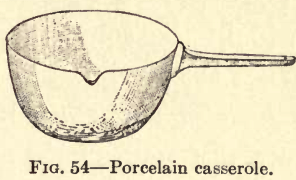
Stir the material being treated from time to time with a glass rod. It is safe to assume that the decomposition is perfect when the silica or residue is clear. When the decomposition of the ore is complete add very gradually a few drops of sulphuric acid to dispel the nitric acid, which must be done before the copper can be perfectly precipitated with iron. If, upon adding a few more drops of sulphuric acid, no more red fumes of nitrous oxide appear, the nitric acid has been driven off. Now evaporate nearly to dryness and add hot water, being careful not to break the container by adding the water too suddenly. Filter and wash the residue on the filter paper several times with very hot water, using the wash bottle. This residue is thoroughly washed when the washings will not coat a bright iron wire with copper. The volume of the filtrate should now be about 6 ounces. (Use 500 c.c. beaker.)
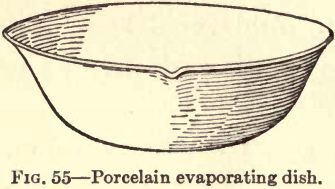
Place a dozen pieces of bright iron wire in the beaker containing the filtrate. (Tenpenny wire nails will answer for this purpose.) Heat the filtrate containing the wires nearly to the boiling point. When the solution becomes clear and no longer deposits a brownish coat upon a clean iron wire held in the solution, the copper is all precipitated. When the precipitation is complete fill the beaker with hot water and allow it to stand ten minutes; then carefully pour off the solution from the wires or nails and precipitated copper. Fill the beaker again with hot water and carefully transfer the wires and water and all of the precipitated copper which is not adhering to the wires to a porcelain evaporating dish (Fig. 55) large enough to receive the contents of the beaker. Rub the wires free from the adhering copper with the fingers, then rinse and remove the wires, being particular that none of the copper is lost. Allow the contents of the dish to settle a few minutes, then decant or pour off the fluid. Again wash the precipitated copper with hot water; settle and pour off. Dry the copper at a gentle heat and when thoroughly dry weigh as metallic copper. (Any danger from oxidizing the copper while drying may be obviated by adding a little alcohol before drying.)
Copper Assay Determination
Divide the weight of the metallic copper recovered by the weight of ore treated, and the result will be the percentage of copper contained in the ore. If 5 grams of ore were treated and 1 gram of copper resulted, the percentage of copper in the ore would be 1 ÷ 5 x 100 = 20, the percentage of copper. This assay is accurate except in cases where the ore contains much tin or antimony. These metals, however, are rarely combined in any quantity with copper ore.
Volumetric Assays
These have been already described as those in which the results arc got by measuring, either—(1) the volume of a reagent required to complete some reaction, or (2) the volume of the resulting product. For example, if a permanganate of potash solution be added to a solution containing a weighed amount of iron, dissolved in sulphuric acid, the strong colour of the permanganate of potash will be removed until a certain quantity of it has been added. Repeating the experiment, it will be found that the same amount of iron decolorises the same volume of the permanganate solution within certain narrow limits of variation, known as “error of experiment.” This error is due to variation in the method of working and to slight differences in the weighings and measurings; it is present in all experimental methods, although the limits of variation are wider in some than in others. Apart from this error of experiment, however, it is certain that a given volume of the permanganate of potash solution corresponds to a definite weight of iron, so that if either is known the other may be calculated. Similarly, if a known weight of zinc (or of carbonate of lime) be dissolved in hydrochloric acid, a gas will be given off which can be measured, and so long as the conditions of the experiment do not vary, the same weight of zinc (or of carbonate of lime) gives off the same volume of gas. The weight of the one can be determined from the volume of the other.
Or, again, the quantity of some substances may be measured by the colour of their solutions, on the principle that, other things being equal, the colour of a solution depends upon the quantity of colouring matter present. So that if two solutions of tho same substance are equally coloured they are of equal strength. In this way an unknown may be compared with a known strength, and a fairly accurate determination may be made. These three illustrations serve as types of the three chief classes of volumetric assays—titrometric, gasometric, and colorimetric.
